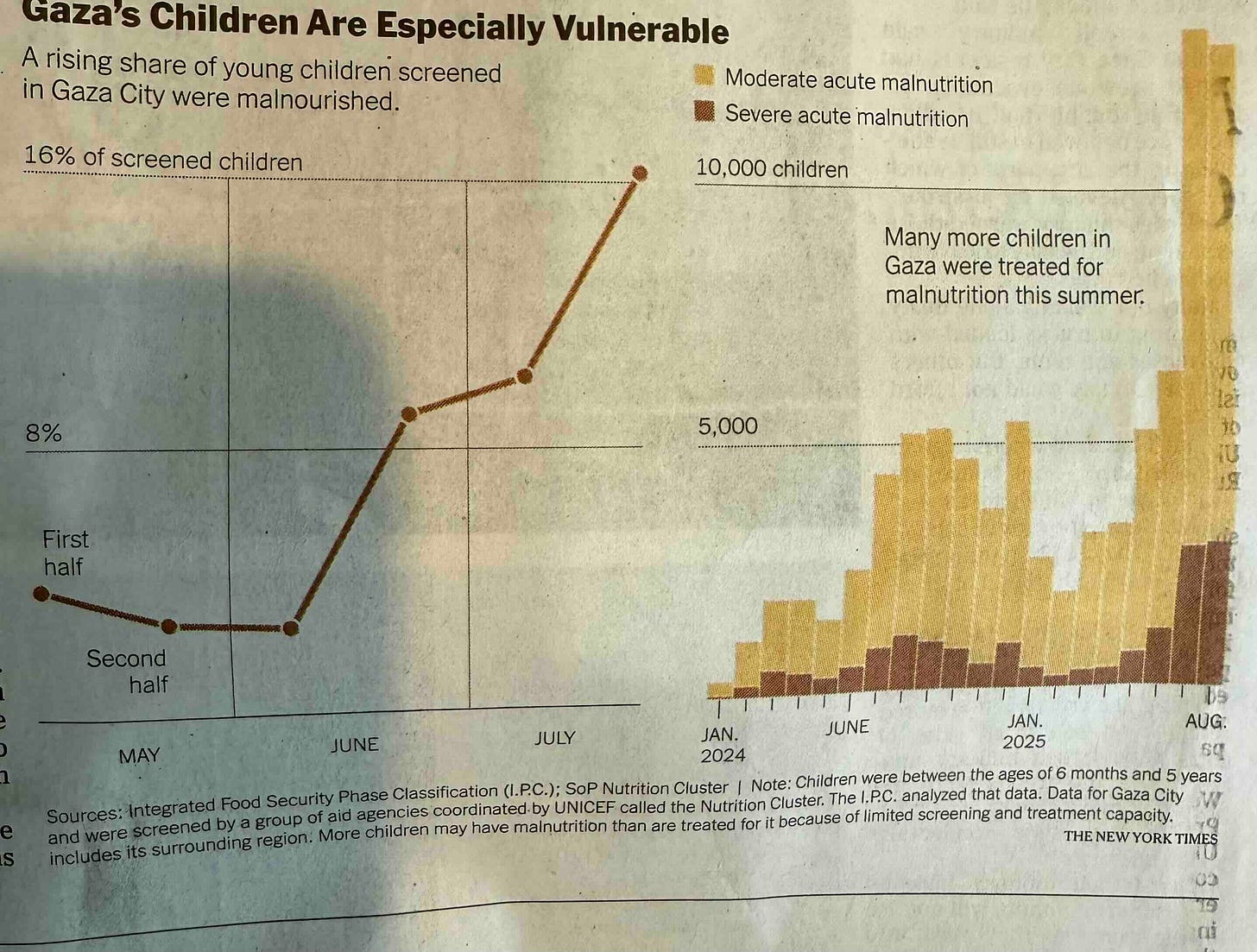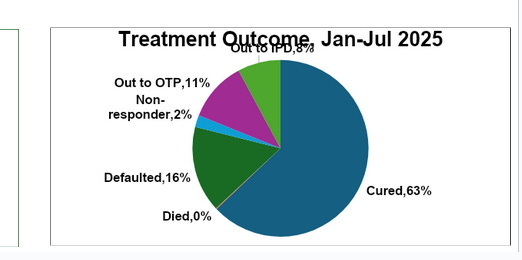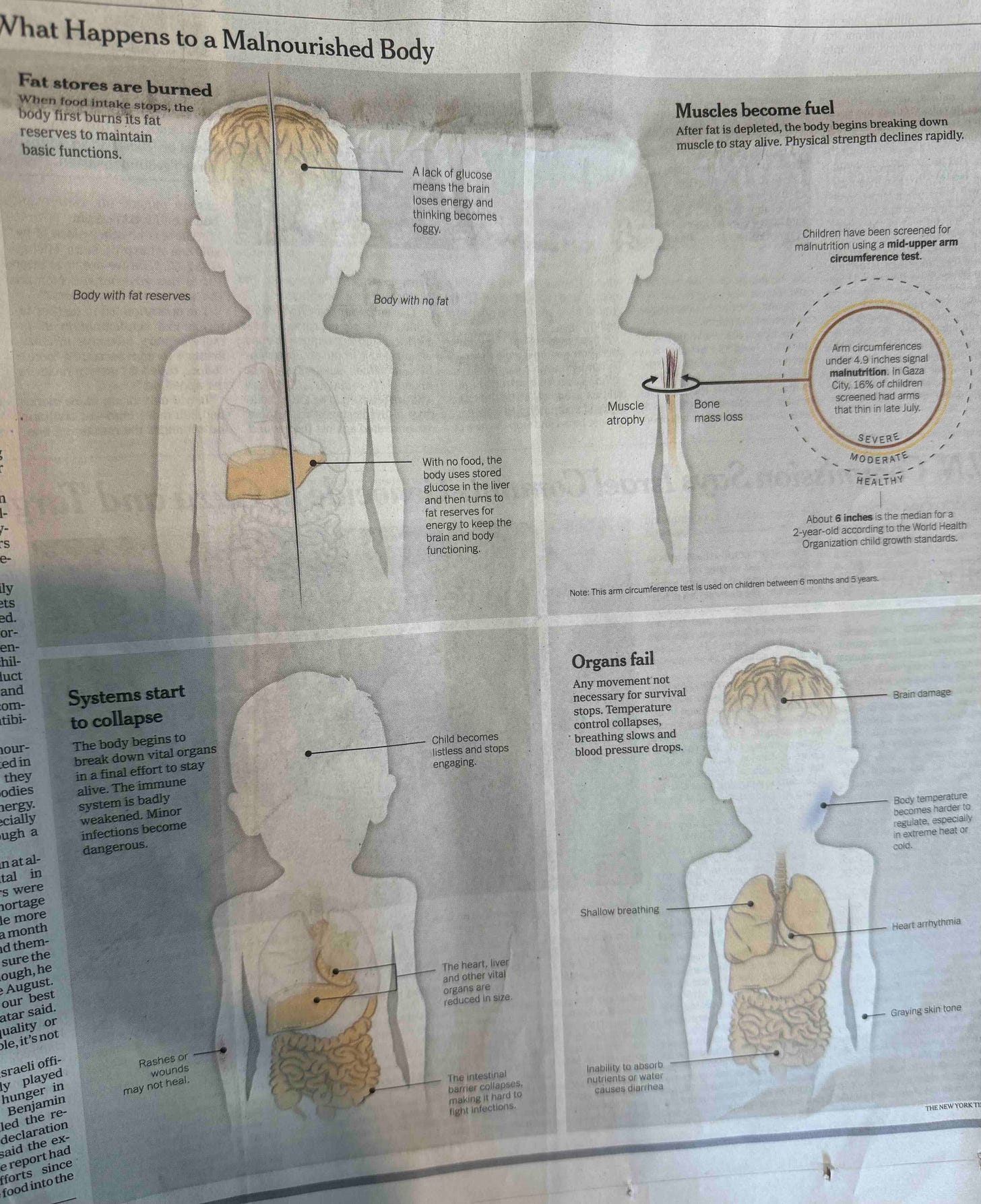New York Times Feeds Readers More Lies About Gaza “Famine”
Plus, the Zohran Mamdani of Seattle; metal detectors come to Harvard, and more
In today’s newsletter: the New York Times lies with Gaza starvation statistics; the Zohran Mamdani of Seattle; New York Times blames Trump for sagging art market; metal detectors are now a Harvard campus security standard.
New York Times lies with Gaza starvation statistics: After the New York Times published a July 30 editors’ note acknowledging a failure fully to level with readers about the preexisting medical condition of a “starving” Gazan child, you’d think the newspaper would try to handle the issue more carefully going forward.
Yet, brazenly, the Times has doubled down on the storyline of “starving” Gazan children, again with illustrations that mislead readers rather than inform them with trustworthy information.
Here’s the first graphic the Times uses for this latest installment in its incessant Israel-Is-Starving-Palestinian-Children series, which appears under the online headline, “This Is What Malnutrition Does to Children’s Bodies” and the subheadline “Why Gaza’s young are especially vulnerable.”

The Times doesn’t supply hyperlinks to the actual data, offering up only fine print that says “Sources: Integrated Food Security Phase Classification (I.P.C.); SoP Nutrition Cluster.” When a news organization does not hyperlink the underlying data, it’s often a strong warning sign that it has something to hide. Sure enough, I did the work and found the source. “SoP” is “State of Palestine,” which, because Palestine is not a state, should also be a caution sign about the reliability of the data. Even with that caveat, though, the linked data tell a story that conflicts with the one the Times is trying to sell readers.
The two Times graphics tell a tale, in numbers, of a worsening “famine” (“In Wartime Gaza, Children Fight to Survive Famine,” is the Times online headline)—sharply rising malnutrition.
Yet the same source—the “State of Palestine Nutrition Cluster,” which is basically a front for UNICEF, dominated by Israel’s enemies—tells a different and more encouraging story, one the Times is withholding from readers. (The Times text concedes that “more aid has gone into Gaza,” but that story is missing from the massive graphics that appear alongside the text.) Here’s a chart from a September 9, 2025 presentation by the State of Palestine Nutrition Cluster showing the dramatic rise in aid flowing into Gaza via UN mechanisms.

And here’s a key chart from the same September 9, 2025, presentation showing that more children being treated for malnutrition actually has a silver lining, because most of those children are reported cured, and zero percent of them died, so getting more malnourished children into treatment may actually have some positive effects.

Of course it’d be better if no Gazans needed treatment for being malnourished. (They wouldn’t if Hamas weren’t using them as human shields and weapons in the propaganda war against Israel.) The Times doesn’t share the zero percent died and 63 percent cured piechart with readers. It apparently didn’t fit the Times definition of “All the News That’s Fit to Print.”
What the Times does share is a giant graphic with an alien-like child with a giant head and super-skinny arms.
The graphic explains that “arm circumferences under 4.9 inches signal malnutrition.” The online version of the article includes some fine-print garbage disclaimer: “Note: The way some devices display graphics mean that the circumferences in the illustration showing the mid-upper arm circumference measurement may not render on some screens as exactly 4.5, 4.9 and 6 inches.” Sorry, the “device” on which this graphic is displayed is the newsprint on which the Times printed it and delivered it to my house, and the flaw in the graphic doesn’t have to do with the device display but with the way the Times constructed it, to exaggerate unrealistically the famine being suffered by the Gazans in a way that therefore portrays Israelis as demonically cruel.
I spent some time measuring the graphic and doing some math. If the image is designed to represent a five-year-old child with a typical head diameter, the arms in the graphic, at scale, are one inch wide. Anatomical dimension-wise, it’s a Jessica Rabbit of Gaza starvation graphics. The Times graphic depicts some anti-Israel activist’s perfervid fantasy of what is happening in Gaza, not reality—which may be why the Times is using illustrations, rather than pictures.
Who are the Times journalists responsible for this ridiculousness? The lead byline on the piece is that of Pablo Robles, whose LinkedIn profile indicates he is based in Seoul, South Korea and worked from 2017 to 2020 in Hong Kong for the Chinese-dominated South China Morning Post. The second byline is that of Stephanie Nolen, who boasts of being “a seven-time winner of the Amnesty International Media Award,” Amnesty being an anti-Israel advocacy group.
It’d be one thing for the Times to be doing this sort of thing if it hadn’t been caught out for using unlabeled photos of people sick with other illnesses as “starving” Gazans on its front page, twice. For it to do this now, after that happened, seems a clear signal that the people running the paper are less interested in offering readers a trustworthy, accurate portrayal of the facts as they are, and more interested in making money off the eagerness of its international and left-leaning audience to read and share content that demonizes Israel. Institutions, including universities, that are paying for enterprise-wide subscriptions for the Times are poisoning their own populations with hate.
Seattle’s Zohran Mamdani: There’s a Zohran Mamdani-like far-left self-described socialist candidate who may well be the next mayor of Seattle. Katie Wilson’s campaign website proposes “a local capital gains tax” along with “a statewide tax on intangible property like stocks and bonds above a high-wealth threshold” and also “A vacancy tax,” “An excise tax on professional services,” “A local estate tax” and “A digital advertising tax.”
What would she spend all that new tax money on? Among other projects, “enable residents to allocate public funds to their favorite local news outlets.. A tenth of one percent of the current city budget could support 50 new full-time reporters.” Imagine how skeptically those reporters will cover the mayor and the effects of the tax increases if they understand that that is the money that pays their salaries, thanks to a Mayor Wilson.
Times blames Trump for sagging art market: From a New York Times news article about a sale by Sotheby’s of some art collected by Leonard Lauder:
In an uncertain economic climate under the Trump administration, collectors have been loath to part with their most prized artworks — unsure of being able to attract top prices. At the same time, collectors have been more tentative about making purchases, uncertain about their financial prospects.
Is the economic climate ever “certain”? Other markets seem to be thriving under Trump, so the idea that any weakness in the art market is attributable to the president seems questionable. The Times just asserts it rather than skeptically analyzing it or attributing the claim to anyone. Later in the article there is an acknowledgement that “A combination of political uncertainty, high interest rates and falling demand from Asian collectors has forced the art market to shrink in recent years — as much as a 12 percent decline in 2024, according to the latest report by Art Basel and UBS.”
Who was president in 2024? And who sets the interest rates? Sure, markets sometimes price in future expectations, and sure, long-term interest rates are affected by things other than the Federal Reserve, but rather than blaming Trump maybe the Times should blame the failures of central planning in China? Or better yet, just write about Leonard Lauder’s art without turning it into a political commentary on President Trump. There is plenty of room in the rest of the newspaper for Trump-related political commentary.
Metal detectors on campus: Yesterday evening I swung by Harvard Square—not for Alan Dershowitz’s appearance at the Harvard Institute of Politics, which I caught afterward on YouTube, but for a National Review Institute and Intercollegiate Studies Institute debate featuring Michael Brendan Dougherty and Daniel McCarthy, moderated by Charles C.W. Cooke, on the question of whether William F. Buckley Jr. was conservative or libertarian. Driving in, I saw that people were passing through metal detector screening on the way into the Dershowitz event. I was also surprised to be wanded for weapons on the way into the Buckley debate, which was at a campus-adjacent hotel. Welcome to the post-Charlie Kirk-assassination era on campus, and please empty your pockets.
For the Dershowitz, if you want to see what happened, I recommend the YouTube video over the Crimson account, which could have used some more careful editing and which shows signs of being handled by someone whose first language does not include definite articles:
Again, I hesitate to criticize the student journalists, but if they are going falsely to accuse (or “accusse”) Israel of genocide, I’m not inclined to cut them much slack. Perhaps the Crimson editors are hoping to render themselves acceptable for future employment at the New York Times.
Thank you! The Editors is a reader-supported publication. We don’t have an endowment or any deals with the government of Qatar. We rely instead on readers like you. If you appreciate the information and analysis and are learning things here that you are not getting elsewhere, please become a paid subscriber today. Paid subscribers have full access to all the content and are helping to sustain our growth and editorial independence. Thanks to those who have already pitched in, at a price of as little as $1.54 a week. If you have trouble making it work on a phone, try a desktop, or if you have trouble on a desktop, try a phone. Or ask some youngster to give you a hand.
If know someone who would enjoy or benefit from reading The Editors, please help us grow, and help your friends, family members, and associates understand the world around them, by forwarding this email along with a suggestion that they subscribe. Or send a gift subscription. If it doesn’t work on mobile, try desktop. Or vice versa. Or ask a tech-savvy youngster to help. Thank you to those of who who have done this recently (we see the results, and they are encouraging) and thanks in advance to the rest of you.






The Crimson and the Times are two of the Nation's Foremost College Newspapers. Employment by the latter of someone from the former would be a lateral move.
I also meant to wish you and your family a happy and healthy New Year.